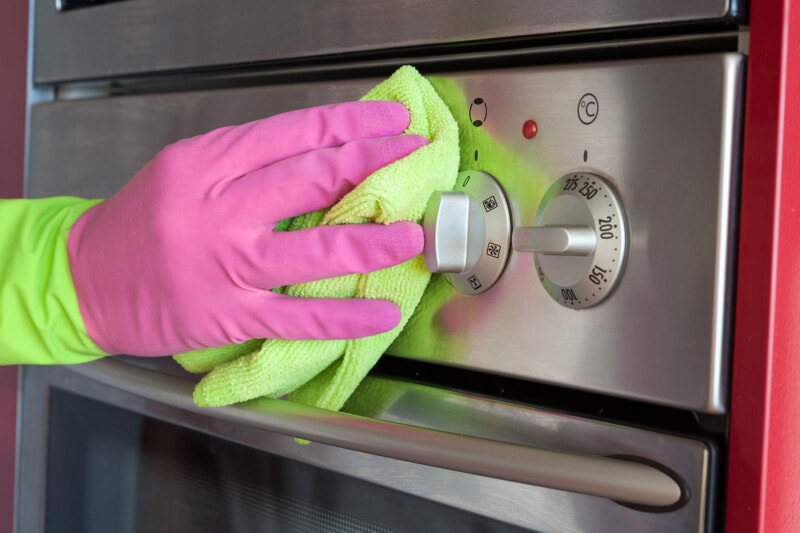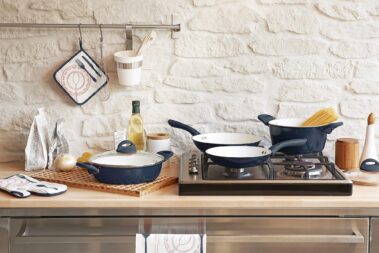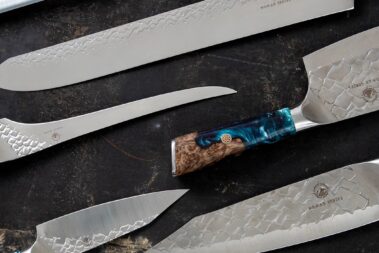When it comes to green cleaning, microfiber cloths may not be the first thing that comes to mind. After all, these rags are made of polyester and nylon, two plastic products that come from the petroleum industry. But the unique ability of these textiles to clean without added chemicals or detergents makes them especially useful for the green kitchen and household.
And considering how many surfaces microfiber can clean—all without additional products—they truly are Earth-friendly in their own unique way.
If you’re looking to add some excellent microfiber products to your green cleaning arsenal, we’ve got the list for you.
Below, you’ll find 7 of the best microfiber cloths for cleaning everything from glass top ranges to couch cushions. These products all have a proven track record for tackling tough cleaning tasks and standing up to repeat use.
Table of Contents
Best Microfiber Cloths at a Glance
- Most Versatile: USANOOKS Microfiber Cleaning Cloth High Performance
- Best Antimicrobial: SOLLIEVO Kitchen Microfiber Cleaning Cloth
- Greenest Option: OnBrand Naturally Wood Fiber Microfiber Cleaning Cloths
- Best for Polishing: Surprise Pie Microfiber Cleaning Cloths
- Best for Scrubbing: Polyte Premium Microfiber Waffle Weave
- Best for Glass: MR.SIGA Ultra Fine Microfiber Cloths for Glass
- Best for Electronics: MagicFiber Microfiber Cleaning Cloth
What to Look for When Choosing a Microfiber Cloth
Microfiber cloths come in a range of different types, from super-fine density cloths used for cleaning sunglasses to thick waffle-pattern rags made for scrubbing. Which type is best largely depends on what you want to use the cloth for.
Materials
Micro cloths made up of a higher ratio of nylon/polyamide to polyester are more likely to last longer. They often also have finer fibers that are better able to capture tiny dirt particles and microbes. Look for products that contain at most 80% polyester for jobs that require durability and a fine touch.
Microfiber Width
Independent of material makeup, different cloths have different microfiber thicknesses. Most cheap options feature fibers that are about 10 to 50 times smaller than a human hair. Quality cloths will have fibers closer to 100 times smaller than a human hair. Some specialty cloths made for disinfecting will have fibers twice as small as even that.
Microfiber Density
In addition to how tiny the fibers are, you’ll also want to pay attention to how densely they are packed into the cloth.
Super-dense towels, which have a grams per square meter density (GSM) of over 300, are great for polishing, cleaning electronic screens, and wiping down glass. Medium density rags (with a GSM around 250) are great for everyday cleaning like wiping down counters and scrubbing the bathroom.
Low-density rags (GSM less than 200) tend to be coarser and are much more likely to leave streaks behind. But they can be useful for tough cleaning jobs, such as scrubbing grease from the oven.
Weave Style
The last thing to look for is the weave style of the cloth.
Loop weave is the most common pattern and results in a surface that is uniform and soft. The microscopic loops are what capture tiny particles and hold them in place. These are particularly helpful for dry or damp jobs, including dusting, polishing, and disinfecting.
Waffle weave rags look more like traditional dishcloths and feature a visible pattern of tall and short weaved fibers. This pattern gives the cloth some added texture that can be helpful in scrubbing tough messes. It also increases the surface area, thereby increasing the amount of water these rags can hold.
This type is best for cleaning wet surfaces, scrubbing away grime, and washing with detergents.
Flat weave cloths have a silky smooth texture that won’t scratch even the most delicate of surfaces. These types are most often used for cleaning glasses, TV screens, and electronics. They are not overly absorbent and are best used for minor cleanup jobs and polishing glass.
The Best Microfiber Cloths for Kitchen and Home
1. USANOOKS Microfiber Cleaning Cloth High Performance

For an all-around great microfiber cloth that can be used on just about every surface imaginable, there is no better choice than USANOOKS’ High-Performance Microfiber Cleaning Cloth.
These all-purpose cleaning cloths were engineered to last. With each one, you’ll get up to 1,200 washes before they need to be replaced. That durability is going to be important because you’ll want to use these versatile rags for just about every cleaning chore you have.
Their 80% polyester, 20% polyamide makeup gives them the perfect combination of high surface area and strength to tackle it all. And with a GSM rating of 300, these adaptable cloths are soft enough for polishing but still absorbent enough to be effective for washing and scrubbing.
Plus, they’re made using a special loop “grip root” weave that makes them even better at capturing microscopic dirt particles and pathogens than competitors.
The best part? They are machine washable for easy cleaning and can even be tossed in the dryer.
2. SOLLIEVO Kitchen Microfiber Cleaning Cloth

For those less sanitary jobs, we recommend the SOLLIEVO Kitchen Microfiber Cleaning Cloth.
These super-micro cloths are made with a higher ratio of nylon to polyester—30% to 70%—that creates even tinier fibers than your typical cloth. These fibers are small enough to capture most bacteria and viruses, making them a great choice for wiping down counters and fixtures in the bathroom and kitchen.
And with a GSM of 340, you can feel confident that those surfaces, whether they’re porcelain, granite, chrome, or glass, will be left with a streak-free shine.
3. OnBrand Naturally Wood Fiber Microfiber Cleaning Cloths

If you’re dead set on staying away from plastics but still want the impressive cleaning power microfiber rags have to offer, your best option is OnBrand Naturally Wood Fiber Microfiber Cleaning Cloths.
To call these natural cleaning cloths microfiber is a bit of a stretch. Unlike true micros, they don’t feature the super-fine frayed yarns that synthetic materials are capable of producing. Instead, these rags use woven, layered wood fiber threads to create a highly absorbent, highly durable rag capable of taking on dozens of tasks around the house.
These non-toxic, chemical-free cloths are soft enough for use on polished wood, lint-free for a streakless shine on mirrors and glass, and highly absorbent for scrubbing and washing. When used dry, the high-density weave allows them to catch tiny dust particles on electronics and baseboards much the same way microfiber does.
Like true micro rags, these well-made cloths will last to help reduce waste. But unlike microfiber, they are far more eco-friendly to produce.
4. Surprise Pie Microfiber Cleaning Cloths

Whether you’re polishing your car after a good wash or rubbing down fixtures in the bathroom, you need these Surprise Pie Microfiber Cleaning Cloths.
With an 80% polyester construction and high 400 GSM, they are super fine and super soft for a scratch-free clean on any surface. Those ultra-fine threads also give them an impressive absorbency that makes them equally useful for washing dishes and wiping down wet surfaces.
These high-quality rags are super affordable and come in a variety of colors. While they are a bit too soft for scrubbing away tough grime, they do make great damp and dry rags for dusting and cleaning electronics. And at this price, you can’t afford not to add at least a few sets of these to your cleaning arsenal.
5. Polyte Premium Microfiber Waffle Weave

If it’s a highly capable scrubbing and cleaning cloth you’re after, let me introduce you to Polyte Premium Microfiber Waffle Weave.
These super-dense rags feature a textured waffle weave pattern that creates extra surface area and some unique scrubbing power. Not only are they capable of absorbing even the biggest messes, but they can make grease and grime disappear.
That special weave makes these Polyte rags especially useful in the kitchen. But the high 300+ GSM rating means they are an equally good choice for washing windows, cleaning mirrors, and polishing fixtures.
6. MR.SIGA Ultra Fine Microfiber Cloths for Glass

For the cleanest mirrors and windows possible, you need these MR.SIGA Ultra Fine Microfiber Cloths for Glass.
These rags sit somewhere between the ultra-fine weave of a sunglass cleaning cloth and the soft surface of a standard microfiber cloth. This smooth texture gives these flat-weave rags the perfect touch to clean and polish glass without damaging surfaces. Start with a damp MR.SIGA cloth to remove smudges and grime, then finish with a dry cloth to polish.
After one use, you’ll be wondering why you spent so long cleaning your glass surfaces with harsh sprays and paper towels. Not only are these rags far simpler to use, but they produce way better results.
7. MagicFiber Microfiber Cleaning Cloth

When it comes to cleaning dust, smudges, grime, and pathogens off of delicate surfaces like phone screens, you want to select a quality, high GSM cloth made for electronics. In this category, we prefer MagicFiber Microfiber Cleaning Cloths.
These flat weave cloths are designed to lift away oils and dust and capture them so they don’t get spread across the surface. This is what makes them so useful for eyeglasses and electronics. They don’t require any water or moisture to be effective and can be used over and over.
MagicFiber rags are also great for cleaning TV screens and musical instruments and for polishing your windows after washing them with a damp lower GSM microfiber towel. They are available in small sets and bulk packs to fit any need.
Everything You Need to Know About Microfiber
How is it that microfiber rags can take on such a variety of jobs and accomplish them to such an impressive degree? Let’s take a closer look.
What Is Microfiber?
Microfiber cloths are specialty textiles made from super-fine polyester and nylon yarns. These tiny threads are split into even smaller microscopic fibers that are less than 1/100th the width of a human hair.
Not only does this give the material a super-soft feel, but it creates a surface area that’s thousands of times larger than that of a traditional cotton rag of the same size.
Why Does It Clean So Well?
It is that extra surface area that makes such a big difference when it comes to cleaning.
All those tiny fibers act on surfaces around them through something known as van de Waals force. Basically, those teeny, tiny fibers pull teeny, tiny particles to them and trap them through something similar to magnetic attraction.
Unlike traditional cloths that require detergents and cleaning sprays to remove dirt and microbes from surfaces before they can wipe them up, microfiber cloths don’t require any surface pretreatment at all.
And better still, specialty microfiber cloths contain fibers small enough to capture most bacteria and viruses present on the surface. This means you can disinfect your home without breaking out any harsh chemicals.
Most dirty microfiber cloths can be tossed in the washing machine and restored to new. Just be sure not to use any fabric softener in the load or it will damage the frayed ends of the rag. Even those that require hand washing are easy to clean with cold water and a little soap.
What Can You Clean with Microfiber?
In short, pretty much everything! Microfiber cloths have characteristics that make them useful in a variety of situations. Here are some of our favorite ways to use microfiber cloths in the home.
- Windows, mirrors, metal – Because microfiber doesn’t release lint, it is the perfect cloth for cleaning windows, mirrors, and shiny metal surfaces. They are smooth enough to not damage surfaces or scratch glass windows. Simply use a damp microfiber cloth to remove dirt and grime, then go over the surface again with a dry microfiber cloth to shine it up.
- Counters – Microfibers are highly absorbent and great for soaking up messes. A micro cloth dampened with warm water can also be used to remove grime and give your counter a shine.
- Baseboards – A dry microfiber towel is your best bet for tackling dust. And this fact is never more apparent than when used for baseboard cleaning. A dry micro cloth will remove all that dust and grime in one wipe.
- Electronics – TV, computer, phone—all these delicate surfaces can all be cleaned with microfiber. And because these cloths clean perfectly well without water or alcohol, they are some of the safest choices for electronics. Not all options are anti-static, however, so be sure you have the right cloth before cleaning any internal components.
- Furniture – Sick of trying to vacuum dog hair off your couch cushions? A dry microfiber cloth is all you need to remove these hard-to-get hairs. For fine hair, like cat hair, use a scrubbing motion to ball up the fur for easy removal. For thicker hairs, like dog hair, brush the hair onto the floor using the cloth then vacuum them up.
- Bathrooms – Micro towels are the perfect bathroom cloth and can easily take on every surface in the room all in one go. A rag dampened with warm water is all you need to shine up faucets, mirrors, and counters. And that same rag will effectively remove bacteria from toilets and shower bases.
- Cars – Next time you wash your car, finish the process with a dry micro towel. The fine fibers will shine up your finish and leave your chrome accents sparkling.
What Is the Best Microfiber Cleaning Cloth?
Since there are a variety of microfiber cloth types, choosing the best one depends on the job at hand.
For those everyday jobs, we highly recommend the USANOOKS Microfiber Cleaning Cloths. These rags feature the perfect combination of materials and optimal GSM rating for washing, scrubbing, dusting, and polishing.
If you need something a little more specialized, like the perfect rag for disinfecting kitchen counters without harsh chemical cleaners, the SOLLIEVO Kitchen Microfiber Cleaning Cloth is the way to go. And for the best window cloth for mirrors, glass top stoves, and other delicate surfaces, you won’t find anything more effective than MR.SIGA Ultra Fine Microfiber Cloths.
Whatever cleaning job you have on your chore list, we’ve got the best microfiber cleaning cloth to get it done featured on our list above.







